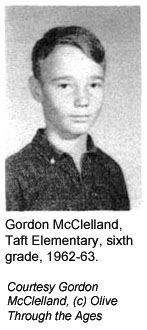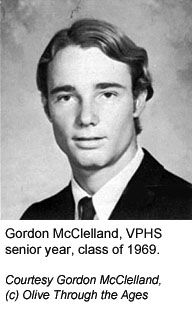|
Olive residents: Memories Citizens
and their homes | Biographies
| Memories Fletcher Avenue area in the early
1960s to mid-1970s NOTE: This story by Gordon McClelland includes 12 numbers in parentheses ( ) which reference pertinent areas marked on the accompanying map.
When I started my sixth grade year in 1962, kids in the area had to be bussed to schools in central Orange. Our bus stop was on the corner of Fletcher Avenue and Glassell Street. (1) We would stand at the foot of the eucalyptus trees, on the edge of an orange grove, waiting for the bus. At six a.m., it was super cold in winter, but we could see the snow-capped mountains so clearly; it seemed they were right there before us. In the early 1960s, orange groves filled most of the area west of the railroad tracks, bordered by Orange-Olive Road, Taft Avenue, Batavia Street, and Fletcher. But north of Fletcher, up to Lincoln Avenue, groves were being removed for the construction of homes. If you went up Glassell Street to Lincoln, the road came to a dead-end. (2) Lincoln was lined with old homes, but behind them were groves extending all the way to the Santa Ana River, except in the area by the R.J. Noble gravel pit. (3) Until about the mid-1960s, an orange grove stood on the south side of Fletcher between Orange-Olive and Glassell in 1963. Then the trees were removed to leave a dirt lot with some palm trees close to where Fletcher met the railroad tracks. (4) Throughout the 1960s, between Glassell and Batavia, 35- to 45-foot-high eucalyptus trees stood with only about three feet between each tree, since these trees were wind blocks surrounding the orange groves. The Porters lived on the south side of Fletcher west of Glassell, in a nicely-designed, 1950s-era ranch style home surrounded on three sides by orange trees. (5) Behind their house was a large barn and some ranch equipment here and there. Beyond the Porter citrus ranch were some old houses, and then a dirt road heading south several hundred yards. On that dirt road was an egg ranch with long rows of chicken coops. (6) Further west were other old buildings, and rusty junk and broken-down cars. There was also a very nice, old, house owned by Santa Ana Valley Irrigation Company, and some type of cement-walled yard on the corner of Fletcher and Batavia. (7)
Our backyard fence stood about 22 feet north of the Porter ranch, so we had a 35-foot-high wall of eucalyptus towering over our home. (8) I'd open my window each night to hear the wind in the trees; sometimes it was pretty loud. The trees had a nice scent, as did the orange blossoms when they bloomed. I had no problem flipping over the fence to either side, between Fletcher and our backyard. In fact, sometimes I'd walk the top edge of that fence back and forth like a tightrope when I got bored! West of our home, between Crestwood and Batavia, were a few older homes I think are still there, (9) and then a large, empty lot. In the middle of that lot was a somewhat run-down, two-story home of 1930s vintage. The structure had white, peeling paint, and a nice, large front porch. The property went all the way back to the irrigation ditch, if I recall correctly. My friend Robert Moyes lived in that house. (10) Beyond that, heading west towards Batavia, was a tropical fish farm. There were outdoor ponds of fish and small buildings with pools of fish, although the people kept them fenced-in and well-guarded, so we rarely saw much. Another egg ranch with rows of chicken coops was also in that same area. Both the tropical fish farm and the egg ranch went most of the way back to the irrigation ditch as well. (11) Fletcher Elementary School was built where the Moyes house, tropical fish farm, and egg ranch once stood. I can’t really recall anything that stands out in my mind from that point west towards Batavia, on the north side of Fletcher. Back then, Fletcher was a through street from Orange-Olive to Batavia. When you turned onto Fletcher from Orange-Olive, there was a roadway incline up to the railroad tracks and then a slight, downhill, roadway slope onto Fletcher. There were no crossing arms to stop drivers from crossing when the train was coming, so there were quite a few collisions through the years. That is the reason they gave for blocking off Fletcher so it now does not go through. I recall seeing some pretty bad accidents when the train hit cars and dragged them far down the tracks. One time, my friend Jim McCollum and I were both on his Stingray bicycle, going down that grade, when a drunk guy in a car hit us and kept going. We yelled and cursed him, but came out with just a few scrapes and bruises, and the bike having some minor damage.
I’m sure where Meats Avenue goes through is a more level area and the visibility is also better. I can't say for sure, but about 1973 would probably be pretty close to when the Fletcher Avenue crossing was closed and the Meats Avenue crossing opened. (12) That was around the time the last of the orange groves between Orange-Olive and Glassell were torn out. About 1974, some cool, old grove houses were removed from Glassell, between Meats and Fletcher. There was a big, old, two-story, Spanish-style place and a couple of two-story, wooden homes. It totally ruined the area for me when all the groves, trees, and cool stuff in the area between Glassell and Orange-Olive were torn out, and the Fletcher crossing was closed, and the Meats crossing opened. In fact, I distinctly recall when they took out the first large grove, and I could visually see from Orange-Olive all the way to Glassell. It actually made me feel sick. That was when I truly came to grips with the fact that the area where I grew up would never look the same again. I'm really glad I have my memories of sitting in the shade of the eucalyptus trees in the newly-plowed, soft, orange grove dirt, looking up the railroad tracks towards Olive while waiting to see the train go by. Some funny little yellow flowers grew on long, thin, lime green stems on the edge of those groves. We called that "sour grass" and would grab it by the handful, stuff it into our mouths, and chew it. I have no idea what it was, but we thought the stems tasted pretty good.
|
||||||||||||
| Copyright © 2005 - Daralee's Web World. All rights reserved. |


